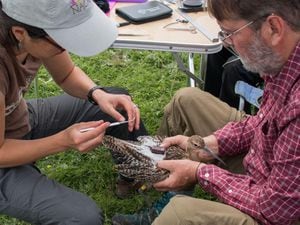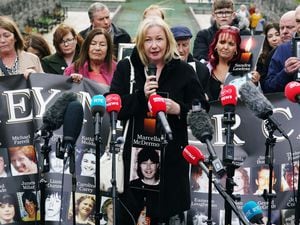Scientists monitor fortunes of newly released curlews as GPS tags ‘phone home’
Two of the more than 80 young birds reared in captivity and released have been fitted with tracking devices.

Rare curlews released into the wild after being reared in captivity are providing scientists with information on their behaviour as their tracking devices “phone home”.
Two of the more than 80 young curlews released at Sandringham and Wild Ken Hill in Norfolk as part of a project to boost the bird’s numbers in the east of England have been fitted with GPS tags.
The data sent back as the tags download daily locations over the mobile phone network are helping scientists monitor the birds’ activities.
The researchers are finding that the released birds are acting like their wild counterparts, but also that – just like people – the two tracked birds have different approaches to life.

All the young birds released at Sandringham and Wild Ken Hill have been fitted with uniquely coded leg rings so they can be identified if they are seen later on, while a sample have been fitted with radio and GPS tags to monitor them.
One of the two curlews with GPS tags, a bird known as “0E”, began exploring its surroundings a few days after release, first in adjacent fields and then further afield and on to the Wash, for short periods initially.
Now it is behaving like the non-breeding curlew that visit the Wash in large numbers over the autumn and winter, the researchers said.
But curlew “3A” has been less adventurous and has mainly stayed around the release site, although it has now begun to explore the nearby Snettisham Coastal Park, the GPS results show.
Curlews, Europe’s largest wading bird, have seen significant declines in numbers since the 1970s due to loss of habitat and predation and are now “red-listed” due to concerns over their conservation status.
The birds released in Norfolk are part of a partnership project for the east of England, led by Government conservation agency Natural England, to boost numbers in the region.
They were reared in captivity from eggs taken from eight military and civilian airfields, where they posed a serious risk to air safety, before being released into the wild in a process known as head-starting.
Dr Sam Franks, senior research ecologist at the British Trust for Ornithology (BTO), said, “These tags have revealed for the first time how young head-started curlew learn about the landscape into which they’ve been released.
“It has been fascinating to observe the different behaviour between individuals.
“Just like people with different personalities, some curlew are more adventurous and exploratory, while others are more risk-averse, avoiding novel conditions and sticking with what they know.”
Dave Slater, director for wildlife licensing and enforcement cases at Natural England, said: “Recovering declining curlew numbers is a priority for us and we are working hard to help boost their numbers.
“This tracking data provides an excellent insight into the behaviour of birds released by this landmark project.
“This early data shows that they are acting like their wild counterparts in their movements and mixing with other wild curlew, which is exactly what we wanted to see.”





